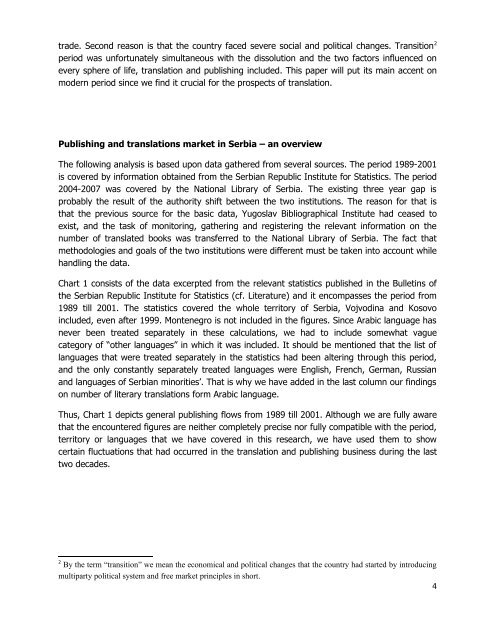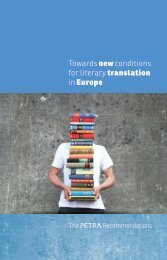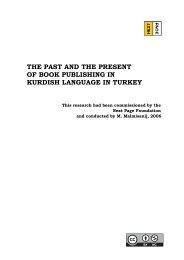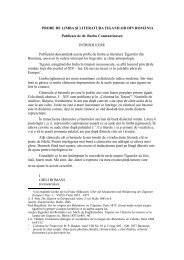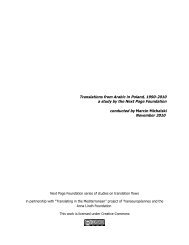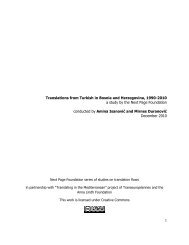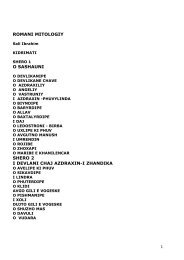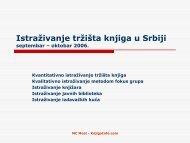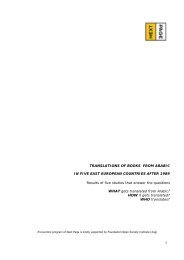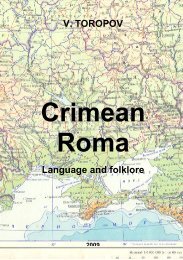Translation activity from Arabic to Bosnian (1989-2010) - Next Page ...
Translation activity from Arabic to Bosnian (1989-2010) - Next Page ...
Translation activity from Arabic to Bosnian (1989-2010) - Next Page ...
- No tags were found...
You also want an ePaper? Increase the reach of your titles
YUMPU automatically turns print PDFs into web optimized ePapers that Google loves.
trade. Second reason is that the country faced severe social and political changes. Transition 2period was unfortunately simultaneous with the dissolution and the two fac<strong>to</strong>rs influenced onevery sphere of life, translation and publishing included. This paper will put its main accent onmodern period since we find it crucial for the prospects of translation.Publishing and translations market in Serbia – an overviewThe following analysis is based upon data gathered <strong>from</strong> several sources. The period <strong>1989</strong>-2001is covered by information obtained <strong>from</strong> the Serbian Republic Institute for Statistics. The period2004-2007 was covered by the National Library of Serbia. The existing three year gap isprobably the result of the authority shift between the two institutions. The reason for that isthat the previous source for the basic data, Yugoslav Bibliographical Institute had ceased <strong>to</strong>exist, and the task of moni<strong>to</strong>ring, gathering and registering the relevant information on thenumber of translated books was transferred <strong>to</strong> the National Library of Serbia. The fact thatmethodologies and goals of the two institutions were different must be taken in<strong>to</strong> account whilehandling the data.Chart 1 consists of the data excerpted <strong>from</strong> the relevant statistics published in the Bulletins ofthe Serbian Republic Institute for Statistics (cf. Literature) and it encompasses the period <strong>from</strong><strong>1989</strong> till 2001. The statistics covered the whole terri<strong>to</strong>ry of Serbia, Vojvodina and Kosovoincluded, even after 1999. Montenegro is not included in the figures. Since <strong>Arabic</strong> language hasnever been treated separately in these calculations, we had <strong>to</strong> include somewhat vaguecategory of “other languages” in which it was included. It should be mentioned that the list oflanguages that were treated separately in the statistics had been altering through this period,and the only constantly separately treated languages were English, French, German, Russianand languages of Serbian minorities’. That is why we have added in the last column our findingson number of literary translations form <strong>Arabic</strong> language.Thus, Chart 1 depicts general publishing flows <strong>from</strong> <strong>1989</strong> till 2001. Although we are fully awarethat the encountered figures are neither completely precise nor fully compatible with the period,terri<strong>to</strong>ry or languages that we have covered in this research, we have used them <strong>to</strong> showcertain fluctuations that had occurred in the translation and publishing business during the lasttwo decades.2 By the term “transition” we mean the economical and political changes that the country had started by introducingmultiparty political system and free market principles in short.4


